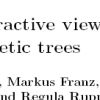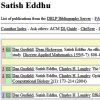| |
|
| |
|
| |
|
| |
   
Guohua Jin,
Luay Nakhleh,
Sagi Snir and
Tamir Tuller. A New Linear-time Heuristic Algorithm for Computing the Parsimony Score of Phylogenetic Networks: Theoretical Bounds and Empirical Performance. In ISBRA07, Vol. 4463:61-72 of LNCS, springer, 2007.
Keywords: approximation, heuristic, parsimony, phylogenetic network, phylogeny, Program Nepal.
Note: http://www.cs.rice.edu/~nakhleh/Papers/isbra07.pdf.
|
|
| |
|
| |
|
| |
|
| |
 
Daniel H. Huson and
Tobias Kloepper. Beyond Galled Trees - Decomposition and Computation of Galled Networks. In RECOMB07, Vol. 4453:211-225 of LNCS, springer, 2007.
Keywords: FPT, from splits, from trees, galled network, phylogenetic network, phylogeny, Program SplitsTree, reconstruction.
Note: http://dx.doi.org/10.1007/978-3-540-71681-5_15, errata..
|
|
| |

Daniel H. Huson. Split networks and Reticulate Networks. In
Olivier Gascuel and
Mike Steel editors, Reconstructing Evolution, New Mathematical and Computational Advances, Pages 247-276, Oxford University Press, 2007.
Keywords: abstract network, consensus, from rooted trees, from sequences, from splits, from unrooted trees, galled tree, hybridization, phylogenetic network, phylogeny, Program Beagle, Program Spectronet, Program SplitsTree, Program SPNet, recombination, reconstruction, split network, survey.
Note: similar to http://www-ab.informatik.uni-tuebingen.de/research/phylonets/GCB2006.pdf.
|
|
| |
|
| |
  
Hadas Birin,
Zohar Gal-Or,
Isaac Elias and
Tamir Tuller. Inferring Models of Rearrangements, Recombinations, and Horizontal Transfers by the Minimum Evolution Criterion. In WABI07, Vol. 4645:111-123 of LNCS, springer, 2007.
Keywords: explicit network, from sequences, phylogenetic network, phylogeny, reconstruction.
Note: http://safrabio.cs.tau.ac.il/download/Papers/Birin_et_al.pdf.
|
|
| |
  
David Bryant,
Vincent Moulton and
Andreas Spillner. Consistency of the Neighbor-Net Algorithm. In AMB, Vol. 2(8), 2007.
Keywords: abstract network, consistency, from distances, NeighborNet.
Note: http://dx.doi.org/10.1186/1748-7188-2-8.
Toggle abstract
"Background: Neighbor-Net is a novel method for phylogenetic analysis that is currently being widely used in areas such as virology, bacteriology, and plant evolution. Given an input distance matrix, Neighbor-Net produces a phylogenetic network, a generalization of an evolutionary or phylogenetic tree which allows the graphical representation of conflicting phylogenetic signals. Results: In general, any network construction method should not depict more conflict than is found in the data, and, when the data is fitted well by a tree, the method should return a network that is close to this tree. In this paper we provide a formal proof that Neighbor-Net satisfies both of these requirements so that, in particular, Neighbor-Net is statistically consistent on circular distances. © 2007 Bryant et al; licensee BioMed Central Ltd."
|
|
| |
 
Patricia Buendia and
Giri Narasimhan. Sliding MinPD: Building evolutionary networks of serial samples via an automated recombination detection approach. In BIO, Vol. 23(22):2993-3000, 2007.
Keywords: from sequences, phylogenetic network, phylogeny, Program Sliding MinPD, recombination, recombination detection, serial evolutionary networks, software.
Note: http://dx.doi.org/10.1093/bioinformatics/btm413.
Toggle abstract
"Motivation: Traditional phylogenetic methods assume tree-like evolutionary models and are likely to perform poorly when provided with sequence data from fast-evolving, recombining viruses. Furthermore, these methods assume that all the sequence data are from contemporaneous taxa, which is not valid for serially-sampled data. A more general approach is proposed here, referred to as the Sliding MinPD method, that reconstructs evolutionary networks for serially-sampled sequences in the presence of recombination. Results: Sliding MinPD combines distance-based phylogenetic methods with automated recombination detection based on the best-known sliding window approaches to reconstruct serial evolutionary networks. Its performance was evaluated through comprehensive simulation studies and was also applied to a set of serially-sampled HIV sequences from a single patient. The resulting network organizations reveal unique patterns of viral evolution and may help explain the emergence of disease-associated mutants and drug-resistant strains with implications for patient prognosis and treatment strategies. © The Author 2007. Published by Oxford University Press. All rights reserved."
|
|
| |
   
Galina Glazko,
Vladimir Makarenkov,
Jing Liu and
Arcady Mushegian. Evolutionary history of bacteriophages with double-stranded DNA genomes. In Biology Direct, Vol. 2(36), 2007.
Keywords: explicit network, from sequences, phylogenetic network, phylogeny, Program T REX.
Note: http://dx.doi.org/10.1186/1745-6150-2-36.
Toggle abstract
"Background: Reconstruction of evolutionary history of bacteriophages is a difficult problem because of fast sequence drift and lack of omnipresent genes in phage genomes. Moreover, losses and recombinational exchanges of genes are so pervasive in phages that the plausibility of phylogenetic inference in phage kingdom has been questioned. Results: We compiled the profiles of presence and absence of 803 orthologous genes in 158 completely sequenced phages with double-stranded DNA genomes and used these gene content vectors to infer the evolutionary history of phages. There were 18 well-supported clades, mostly corresponding to accepted genera, but in some cases appearing to define new taxonomic groups. Conflicts between this phylogeny and trees constructed from sequence alignments of phage proteins were exploited to infer 294 specific acts of intergenome gene transfer. Conclusion: A notoriously reticulate evolutionary history of fast-evolving phages can be reconstructed in considerable detail by quantitative comparative genomics. © 2007 Glazko et al; licensee BioMed Central Ltd."
|
|
| |
|
| |
|
| |
     
Daniel H. Huson,
Daniel C. Richter,
Christian Rausch,
Tobias Dezulian,
Markus Franz and
Regula Rupp. Dendroscope: An interactive viewer for large phylogenetic trees. In BMCB, Vol. 8:460, 2007.
Keywords: phylogeny, Program Dendroscope, software, visualization.
Note: http://dx.doi.org/10.1186/1471-2105-8-460, slides available at http://www.newton.cam.ac.uk/webseminars/pg+ws/2007/plg/plgw01/0903/huson/, software freely available from http://www.dendroscope.org.
Toggle abstract
"Background: Research in evolution requires software for visualizing and editing phylogenetic trees, for increasingly very large datasets, such as arise in expression analysis or metagenomics, for example. It would be desirable to have a program that provides these services in an effcient and user-friendly way, and that can be easily installed and run on all major operating systems. Although a large number of tree visualization tools are freely available, some as a part of more comprehensive analysis packages, all have drawbacks in one or more domains. They either lack some of the standard tree visualization techniques or basic graphics and editing features, or they are restricted to small trees containing only tens of thousands of taxa. Moreover, many programs are diffcult to install or are not available for all common operating systems. Results: We have developed a new program, Dendroscope, for the interactive visualization and navigation of phylogenetic trees. The program provides all standard tree visualizations and is optimized to run interactively on trees containing hundreds of thousands of taxa. The program provides tree editing and graphics export capabilities. To support the inspection of large trees, Dendroscope offers a magnification tool. The software is written in Java 1.4 and installers are provided for Linux/Unix, MacOS X and Windows XP. Conclusion: Dendroscope is a user-friendly program for visualizing and navigating phylogenetic trees, for both small and large datasets. © 2007 Huson et al; licensee BioMed Central Ltd."
|
|
| |
 
Maria S. Poptsova and
J. Peter Gogarten. The power of phylogenetic approaches to detect horizontally transferred genes. In BMCEB, Vol. 7(45), 2007.
Keywords: evaluation, from rooted trees, lateral gene transfer, Program EEEP.
Note: http://dx.doi.org/10.1186/1471-2148-7-45.
Toggle abstract
"Background. Horizontal gene transfer plays an important role in evolution because it sometimes allows recipient lineages to adapt to new ecological niches. High genes transfer frequencies were inferred for prokaryotic and early eukaryotic evolution. Does horizontal gene transfer also impact phylogenetic reconstruction of the evolutionary history of genomes and organisms? The answer to this question depends at least in part on the actual gene transfer frequencies and on the ability to weed out transferred genes from further analyses. Are the detected transfers mainly false positives, or are they the tip of an iceberg of many transfer events most of which go undetected by current methods? Results. Phylogenetic detection methods appear to be the method of choice to infer gene transfers, especially for ancient transfers and those followed by orthologous replacement. Here we explore how well some of these methods perform using in silico transfers between the terminal branches of a gamma proteobacterial, genome based phylogeny. For the experiments performed here on average the AU test at a 5% significance level detects 90.3% of the transfers and 91% of the exchanges as significant. Using the Robinson-Foulds distance only 57.7% of the exchanges and 60% of the donations were identified as significant. Analyses using bipartition spectra appeared most successful in our test case. The power of detection was on average 97% using a 70% cut-off and 94.2% with 90% cut-off for identifying conflicting bipartitions, while the rate of false positives was below 4.2% and 2.1% for the two cut-offs, respectively. For all methods the detection rates improved when more intervening branches separated donor and recipient. Conclusion. Rates of detected transfers should not be mistaken for the actual transfer rates; most analyses of gene transfers remain anecdotal. The method and significance level to identify potential gene transfer events represent a trade-off between the frequency of erroneous identification (false positives) and the power to detect actual transfer events. © 2007 Poptsova and Gogarten; licensee BioMed Central Ltd."
|
|
| |
 
Magnus Bordewich and
Charles Semple. Computing the minimum number of hybridization events for a consistent evolutionary history. In DAM, Vol. 155:914-918, 2007.
Keywords: agreement forest, approximation, APX hard, explicit network, from rooted trees, hybridization, inapproximability, NP complete, phylogenetic network, phylogeny, SPR distance.
Note: http://www.math.canterbury.ac.nz/~c.semple/papers/BS06a.pdf.
|
|
| |
  
Dan Gusfield,
Dean Hickerson and
Satish Eddhu. An efficiently computed lower bound on the number of recombinations in phylogenetic networks: Theory and empirical study. In DAM, Vol. 155(6-7):806-830, 2007.
Note: http://wwwcsif.cs.ucdavis.edu/~gusfield/cclowerbound.pdf.
Toggle abstract
"Phylogenetic networks are models of sequence evolution that go beyond trees, allowing biological operations that are not tree-like. One of the most important biological operations is recombination between two sequences. An established problem [J. Hein, Reconstructing evolution of sequences subject to recombination using parsimony, Math. Biosci. 98 (1990) 185-200; J. Hein, A heuristic method to reconstruct the history of sequences subject to recombination, J. Molecular Evoluation 36 (1993) 396-405; Y. Song, J. Hein, Parsimonious reconstruction of sequence evolution and haplotype blocks: finding the minimum number of recombination events, in: Proceedings of 2003 Workshop on Algorithms in Bioinformatics, Berlin, Germany, 2003, Lecture Notes in Computer Science, Springer, Berlin; Y. Song, J. Hein, On the minimum number of recombination events in the evolutionary history of DNA sequences, J. Math. Biol. 48 (2003) 160-186; L. Wang, K. Zhang, L. Zhang, Perfect phylogenetic networks with recombination, J. Comput. Biol. 8 (2001) 69-78; S.R. Myers, R.C. Griffiths, Bounds on the minimum number of recombination events in a sample history, Genetics 163 (2003) 375-394; V. Bafna, V. Bansal, Improved recombination lower bounds for haplotype data, in: Proceedings of RECOMB, 2005; Y. Song, Y. Wu, D. Gusfield, Efficient computation of close lower and upper bounds on the minimum number of needed recombinations in the evolution of biological sequences, Bioinformatics 21 (2005) i413-i422. Bioinformatics (Suppl. 1), Proceedings of ISMB, 2005, D. Gusfield, S. Eddhu, C. Langley, Optimal, efficient reconstruction of phylogenetic networks with constrained recombination, J. Bioinform. Comput. Biol. 2(1) (2004) 173-213; D. Gusfield, Optimal, efficient reconstruction of root-unknown phylogenetic networks with constrained and structured recombination, J. Comput. Systems Sci. 70 (2005) 381-398] is to find a phylogenetic network that derives an input set of sequences, minimizing the number of recombinations used. No efficient, general algorithm is known for this problem. Several papers consider the problem of computing a lower bound on the number of recombinations needed. In this paper we establish a new, efficiently computed lower bound. This result is useful in methods to estimate the number of needed recombinations, and also to prove the optimality of algorithms for constructing phylogenetic networks under certain conditions [D. Gusfield, S. Eddhu, C. Langley, Optimal, efficient reconstruction of phylogenetic networks with constrained recombination, J. Bioinform. Comput. Biol. 2(1) (2004) 173-213; D. Gusfield, Optimal, efficient reconstruction of root-unknown phylogenetic networks with constrained and structured recombination, J. Comput. Systems Sci. 70 (2005) 381-398; D. Gusfield, Optimal, efficient reconstruction of root-unknown phylogenetic networks with constrained recombination, Technical Report, Department of Computer Science, University of California, Davis, CA, 2004]. The lower bound is based on a structural, combinatorial insight, using only the site conflicts and incompatibilities, and hence it is fundamental and applicable to many biological phenomena other than recombination, for example, when gene conversions or recurrent or back mutations or cross-species hybridizations cause the phylogenetic history to deviate from a tree structure. In addition to establishing the bound, we examine its use in more complex lower bound methods, and compare the bounds obtained to those obtained by other established lower bound methods. © 2006 Elsevier B.V. All rights reserved."
|
|
| |
   
Magnus Bordewich,
Simone Linz,
Katherine St. John and
Charles Semple. A reduction algorithm for computing the hybridization number of two trees. In EBIO, Vol. 3:86-98, 2007.
Keywords: agreement forest, FPT, from rooted trees, hybridization, phylogenetic network, phylogeny, Program HybridNumber.
Note: http://www.math.canterbury.ac.nz/~c.semple/papers/BLSS07.pdf.
|
|
| |
    
Joanna L. Davies,
Frantisek Simancík,
Rune Lyngsø,
Thomas Mailund and
Jotun Hein. On Recombination-Induced Multiple and Simultaneous Coalescent Events. In GEN, Vol. 177:2151-2160, 2007.
Keywords: coalescent, phylogenetic network, phylogeny, recombination, statistical model.
Note: http://dx.doi.org/10.1534/genetics.107.071126.
Toggle abstract
"Coalescent theory deals with the dynamics of how sampled genetic material has spread through a population from a single ancestor over many generations and is ubiquitous in contemporary molecular population genetics. Inherent in most applications is a continuous-time approximation that is derived under the assumption that sample size is small relative to the actual population size. In effect, this precludes multiple and simultaneous coalescent events that take place in the history of large samples. If sequences do not recombine, the number of sequences ancestral to a large sample is reduced sufficiently after relatively few generations such that use of the continuous-time approximation is justified. However, in tracing the history of large chromosomal segments, a large recombination rate per generation will consistently maintain a large number of ancestors. This can create a major disparity between discrete-time and continuous-time models and we analyze its importance, illustrated with model parameters typical of the human genome. The presence of gene conversion exacerbates the disparity and could seriously undermine applications of coalescent theory to complete genomes. However, we show that multiple and simultaneous coalescent events influence global quantities, such as total number of ancestors, but have negligible effect on local quantities, such as linkage disequilibrium. Reassuringly, most applications of the coalescent model with recombination (including association mapping) focus on local quantities. Copyright © 2007 by the Genetics Society of America."
|
|
| |
|
| |
   
Dan Gusfield,
Vikas Bansal,
Vineet Bafna and
Yun S. Song. A Decomposition Theory for Phylogenetic Networks and Incompatible Characters. In JCB, Vol. 14(10):1247-1272, 2007.
Keywords: explicit network, from sequences, galled tree, phylogenetic network, phylogeny, Program Beagle, Program GalledTree, recombination, reconstruction, software.
Note: http://www.eecs.berkeley.edu/~yss/Pub/decomposition.pdf.
|
|
| |
    
Yun S. Song,
Zhihong Ding,
Dan Gusfield,
Charles Langley and
Yufeng Wu. Algorithms to Distinguish the Role of Gene-Conversion from Single-Crossover Recombination in the Derivation of SNP Sequences in Populations. In JCB, Vol. 14(10):1273-1286, 2007.
Keywords: ARG, from sequences, phylogenetic network, phylogeny, Program SHRUB, reconstruction.
Note: http://dx.doi.org/10.1089/cmb.2007.0096.
Toggle abstract
"Meiotic recombination is a fundamental biological event and one of the principal evolutionary forces responsible for shaping genetic variation within species. In addition to its fundamental role, recombination is central to several critical applied problems. The most important example is "association mapping" in populations, which is widely hoped to help find genes that influence genetic diseases (Carlson et al., 2004; Clark, 2003). Hence, a great deal of recent attention has focused on problems of inferring the historical derivation of sequences in populations when both mutations and recombinations have occurred. In the algorithms literature, most of that recent work has been directed to single-crossover recombination. However, gene-conversion is an important, and more common, form of (two-crossover) recombination which has been much less investigated in the algorithms literature. In this paper, we explicitly incorporate gene-conversion into discrete methods to study historical recombination. We are concerned with algorithms for identifying and locating the extent of historical crossing-over and gene-conversion (along with single-nucleotide mutation), and problems of constructing full putative histories of those events. The novel technical issues concern the incorporation of gene-conversion into recently developed discrete methods (Myers and Griffiths, 2003; Song et al., 2005) that compute lower and upper-bound information on the amount of needed recombination without gene-conversion. We first examine the most natural extension of the lower bound methods from Myers and Griffiths (2003), showing that the extension can be computed efficiently, but that this extension can only yield weak lower bounds. We then develop additional ideas that lead to higher lower bounds, and show how to solve, via integer-linear programming, a more biologically realistic version of the lower bound problem. We also show how to compute effective upper bounds on the number of needed single-crossovers and gene-conversions, along with explicit networks showing a putative history of mutations, single-crossovers and gene-conversions. Both lower and upper bound methods can handle data with missing entries, and the upper bound method can be used to infer missing entries with high accuracy. We validate the significance of these methods by showing that they can be effectively used to distinguish simulation-derived sequences generated without gene-conversion from sequences that were generated with gene-conversion. We apply the methods to recently studied sequences of Arabidopsis thaliana, identifying many more regions in the sequences than were previously identified (Plagnol et al., 2006), where gene-conversion may have played a significant role. Demonstration software is available at www.csif.cs.ucdavis.edu/∼gusfield. © 2007 Mary Ann Liebert, Inc."
|
|
| |
   
Cuong Than,
Derek Ruths,
Hideki Innan and
Luay Nakhleh. Confounding Factors in HGT Detection: Statistical Error, Coalescent Effects, and Multiple Solutions. In JCB, Vol. 14(4):517-535, 2007.
Keywords: counting, explicit network, from rooted trees, from species tree, lateral gene transfer, phylogenetic network, phylogeny, Program LatTrans, Program PhyloNet.
Note: http://www.cs.rice.edu/~nakhleh/Papers/recombcg06-jcb.pdf.
|
|
| |
  
Cam Thach Nguyen,
Nguyen Bao Nguyen and
Wing-Kin Sung. Fast Algorithms for computing the Tripartition-based Distance between Phylogenetic Networks. In JCO, Vol. 13(3), 2007.
Keywords: distance between networks, phylogenetic network, phylogeny, tripartition distance.
Note: http://dx.doi.org/10.1007/s10878-006-9025-5.
Toggle abstract
"Consider two phylogenetic networks N and N′ of size n. The tripartition-based distance finds the proportion of tripartitions which are not shared by N and N′. This distance is proposed by Moret et al. (2004) and is a generalization of Robinson-Foulds distance, which is orginally used to compare two phylogenetic trees. This paper gives an O(min {kn log n, n log n + hn} -time algorithm to compute this distance, where h is the number of hybrid nodes in N and N′ while k is the maximum number of hybrid nodes among all biconnected components in N and N′. Note that k ≪ h ≪ n in a phylogenetic network. In addition, we propose algorithms for comparing galled-trees, which are an important, biological meaningful special case of phylogenetic network. We give an O(n)-time algorithm for comparing two galled-trees. We also give an O(n + kh)-time algorithm for comparing a galled-tree with another general network, where h and k are the number of hybrid nodes in the latter network and its biggest biconnected component respectively. © Springer Science+Business Media, LLC 2007."
|
|
| |
   
Stefan Grünewald,
Kristoffer Forslund,
Andreas W. M. Dress and
Vincent Moulton. QNet: An agglomerative method for the construction of phylogenetic networks from weighted quartets. In MBE, Vol. 24(2):532-538, 2007.
Keywords: abstract network, circular split system, from quartets, phylogenetic network, phylogeny, Program QNet, reconstruction, software.
Note: http://mbe.oxfordjournals.org/cgi/content/abstract/24/2/532.
Toggle abstract
"We present QNet, a method for constructing split networks from weighted quartet trees. QNet can be viewed as a quartet analogue of the distance-based Neighbor-Net (NNet) method for network construction. Just as NNet, QNet works by agglomeratively computing a collection of circular weighted splits of the taxa set which is subsequently represented by a planar split network. To illustrate the applicability of QNet, we apply it to a previously published Salmonella data set. We conclude that QNet can provide a useful alternative to NNet if distance data are not available or a character-based approach is preferred. Moreover, it can be used as an aid for determining when a quartet-based tree-building method may or may not be appropriate for a given data set. QNet is freely available for download. © The Author 2006. Published by Oxford University Press on behalf of the Society for Molecular Biology and Evolution. All rights reserved."
|
|
| |
   
Katharina Huber,
Bengt Oxelman,
Martin Lott and
Vincent Moulton. Reconstructing the Evolutionary History of Polyploids from Multilabeled Trees. In MBE, Vol. 23(9):1784-1791, 2007.
Keywords: duplication, explicit network, from multilabeled tree, from trees, phylogenetic network, phylogeny, Program PADRE, reconstruction, software.
Note: http://mbe.oxfordjournals.org/cgi/content/full/23/9/1784.
Toggle abstract
"In recent studies, phylogenetic networks have been derived from so-called multilabeled trees in order to understand the origins of certain polyploids. Although the trees used in these studies were constructed using sophisticated techniques in phylogenetic analysis, the presented networks were inferred using ad hoc arguments that cannot be easily extended to larger, more complicated examples. In this paper, we present a general method for constructing such networks, which takes as input a multilabeled phylogenetic tree and outputs a phylogenetic network with certain desirable properties. To illustrate the applicability of our method, we discuss its use in reconstructing the evolutionary history of plant allopolyploids. We conclude with a discussion concerning possible future directions. The network construction method has been implemented and is freely available for use from http://www.uea.ac.uk/ ∼a043878/padre.html. © The Author 2006. Published by Oxford University Press on behalf of the Society for Molecular Biology and Evolution. All rights reserved."
|
|
| |
|
|